Essay #5 Yin/Yang & the Hemispheres of the Brain
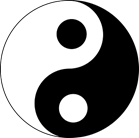
“A spiral, folding within itself….”
Light and Dark submerging within and emerging from out of each other….
Unconscious and Conscious thoughts, feelings, urges interweaving….
The Yin/Yang symbol of the Tao, one of the most enduring in the perennial philosophy, is a great diving off point for contemplating a shift in emphasis to the right hemisphere of our brains in order to regain our emotional/psychological/spiritual balance here in the 21st century.
Soon after choosing philosophy as my college major, I encountered this symbol for the first time while browsing in a college book store. Over 50 years later, I’m still mesmerized by both its simplicity and complexity all at once.
On the “explicate” level, it’s relatively simple: black and white sections of a circle divided evenly by a spiral, a white dot within the black, a black dot within the white.
But the deeper “implicit” levels are what stopped me in my tracks (although I had no reason why) and are the powerful magnetic pull that has made it one of the most enduring symbols in human evolution.
As brought up in previous essays, the left hemisphere of our brains is skilled at breaking things down into smaller parts and analyzing how they are put together (explicit). The right hemisphere is wired to get a bigger picture or deeper “implicit” meaning which often can’t be best explained in words, but understood at an intuitively felt level.
A common phrase used to define what the yin/yang symbol represents is “Unity of opposites.” On the explicate level, the black and white sections can be perceived as two opposing forces. On the implicate level, according to many Taoist accounts, the opposing forces are generated from an underlying, unseen unity/harmony.
So, at the explicate level, yin/yang can reflect a constant pattern of conflict, opposition and competition. From the perspective of the right hemisphere, as taught through the millennia by more intuitive philosophers and spiritual sages, the spiral within the circle reflects a continuous flow between the black and the white which co-exist in an underlying harmony.
Diving into the Spiraling Wave
As with many explorations of ancient Asian wisdom, I turn to one of the most gifted teachers at evoking this wisdom and applying it to our modern age: Alan Watts.
He once stated:
“The yin/yang symbol is a spiral folding within itself.”
With this perspective, let’s dive in.
Often a good place to start when exercising right hemisphere modes of perception is a teaching tale. Here is one of the most famous Taoist stories, as written in Alan Watts’ book Tao: The Watercourse Way:
“There was a farmer whose horse ran away. That evening the neighbors gathered to commiserate with him since this was such bad luck. He said, “May be.”
The next day the horse returned, but brought with it six wild horses, and the neighbors came exclaiming at his good fortune. He said, “May be.”
And then, the following day, his son tried to saddle and ride one of the wild horses, was thrown, and broke his leg.
Again, the neighbors came to offer their sympathy for the misfortune. He said, “May be.”
The day after that, conscription officers came to the village to seize young men for the army, but because of the broken leg the farmer’s son was rejected. When the neighbors came in to say how fortunately everything had turned out, he said, “May be.”
You can hear Alan Watts talking about yin/yang here.
He comments on the fact that the symbol contains a white dot in the black pattern and a black dot in the white pattern:
“Obviously black and white are as different as different can be…but strangely black is white in a strange sense. And white is black…because black implies white and white implies black. All positive implies negative and negative implies positive. Because you can’t have the one without the other. To put this into clear words we can say explicatively, black and white are different. But implicitly…they are one. So outwardly, the positive and negative of life are very different. Life is different from death and good is different from evil. But esoterically, secretively, they are one.”
“Thus, rather than seeing nature as a conquest between opposing forces, the cold vs the heat, the light vs the dark, the day vs the night, man vs woman, the principle of the Yin-Yang is that of mutually-arising. That is to say, to adopt an organic view of nature and appreciate the underlying unity behind the apparent duality.
To demonstrate cooperation and harmony in all the various phenomena of nature.”
Nature’s Expression of Yin/Yang
Contemplating down to an individual atom, the building block of nature, we find the unity underlying the apparent opposition: Each atom contains a proton with a positive charge and electrons with negative charge.
At its core, nature generates symmetry through opposites attracting and like repelling.
In the plant world, we easily get entranced by the beauty of the flowers and the trunk, branches and leaves of a tree reaching up towards the sunlight. But that is only half the story.


As beautiful as these photos are, they leave out ½ of the whole picture…As if being captivated by the white section of the yin/yang symbol, being blind to the dark section.
The missing part? The roots pushing deep into the dark muck of the earth for sustenance, without which the trees we see in the above photographs couldn’t exist, a vivid example of the “explicit” (left hemisphere) being overemphasized to such a degree that the “implicit” roots of life are forgotten.
And science is now telling us that at the “root” level, trees communicate with each in life-enhancing ways. As described in the article published by Smithsonian Magazine, “Do Trees Talk to Each Other?” based on observations by German forester Peter Wohlleben,
“A revolution has been taking place in the scientific understanding of trees, and Wohlleben is the first writer to convey its amazements to a general audience. The latest scientific studies, conducted at well-respected universities in Germany and around the world, confirm what he has long suspected from close observation in this forest: Trees are far more alert, social, sophisticated—and even intelligent—than we thought…”
The article goes on to confirm a significant understanding of evolution:
“Since Darwin, we have generally thought of trees as striving, disconnected loners, competing for water, nutrients and sunlight, with the winners shading out the losers and sucking them dry. The timber industry in particular sees forests as wood-producing systems and battlegrounds for survival of the fittest.
There is now a substantial body of scientific evidence that refutes that idea. It shows instead that trees of the same species are communal…These soaring columns of living wood draw the eye upward to their outspreading crowns, but the real action is taking place underground, just a few inches below our feet.
“Some are calling it the ‘wood-wide web,’ says Wohlleben.”

The “wood-wide web” clearly includes both underground at the root level as well above ground.
At the same time evidence such as the “wood-wide web,” as detailed in the Smithsonian Magazine article, reveals nature is much more collaborative than competitive, culturally we are still stuck in the constrained paradigm that evolution is based on a ‘survival of the fittest’ based on material gains and competition. The yin/yang symbol reflects the need for collaborative harmony, not getting stuck in the explicate at the cost of missing the implicate.
Wave Theory


At the deep, implicit level of what many ancient Asian sages were tuned into, Yin and Yang, dark and light, can’t be well understood taken separately. As Alan Watts pointed out, the spiral which visually separates them in the symbol is “folding in on itself.” So, if we imagine the symbol in motion, the black and white sections would be submerging into and emerging out of each other, understandable only as a ‘mutual whole.’
There is another powerful example we’ve all shared that can tune into a deeper understanding of this underlying ‘mutual whole’………. Watching waves rise and fall as they approach the shoreline.
On the visual, explicit level, we can distinguish one wave from another as they rise out of the surface. Each wave is clearly separate from the others. But are they?
It’s virtually impossible to accurately measure where an individual wave begins and ends. For at the moment of the measurement, the wave has shifted its position from the ocean out of which it emerges. And while at the explicit level, we can see general dimensions as the wave rises and falls, did the visual wave ever fully separate itself from the ocean as a whole?
It can’t. For beneath the surface of the water each wave is being shaped and formed by the underlying tidal forces not just locally, but throughout the entire undersea tidal dynamics of the ocean at large.
So, at the same time a surfer can choose to ride one particular wave over another and we can distinguish each wave from others, in reality each wave is intricately woven into the expansive push/pull currents of the entire ocean.
The importance of understanding the deeper dynamic of wave/ocean is noted by Alan Watts:
“This (the yin/yang symbol) implies that the art of life is more like navigation than warfare, for what is important is to understand the winds, the tides, the currents, the seasons, and the principles of growth and decay, so that one’s actions may use them and not fight them.
At the very roots of ancient Chinese thinking and feeling there lies the principle of polarity, which is not to be confused with the ideas of opposition or conflict. In the metaphors of other cultures, light is at war with darkness, life with death, good with evil, and the positive with the negative, and thus an idealism to cultivate the former and be rid of the latter flourishes throughout much of the world.”

Riding the Quantum Wave
As previously mentioned, the ancient yin/yang symbol is one of the keystones of the perennial philosophy, those transcendent insights that continue to spark the continuing search for deep, edifying patterns of existence. While primarily an insight in philosophy and spiritual teachings, the yin/yang symbol has influenced science as well.
Niels Bohr, the Nobel Prize-winning scientist whose institute in Copenhagen was the main center for development of quantum physics, was offered a Danish knighthood in 1947. One of the perks was the opportunity to construct a personal coat of arms. Bohr chose as its central image: The yin/yang symbol.
This is quite interesting to our topic since it was Bohr who created the most enduring philosophical interpretation of the mysterious contradictions inherent in quantum physics. Despite the fact that quantum physics is the most successful scientific theory ever (responsible for the current computer driven digital age), at its core, confirmed by multiple experiments, is the bizarre mystery that at the subatomic level an entity such as a photon (which makes up light) or an electron (which makes up electricity) can be either a particle or a wave, depending on how the experiment is set up.
This makes no logical sense. A particle has finite, discernible boundaries–a wave is diffused and has no clear boundaries. How could anything be neither definitively one or the other, but potentially either one?
As physicist David Harrison describes the mystery of Wave/particle duality and Bohr’s philosophical vision called “complementarity:”
“We can think of an electron as a wave or we can think of an electron as a particle, but we cannot think of it as both at once. But in some sense the electron is both at once. Being able to think of these two viewpoints at once is in some sense being able to understand Quantum Mechanics.”
To think of “two viewpoints at once” connects beautifully to Buddhist teacher Robert Thurman’s statement, cited previously on this website:
“Wisdom is tolerance of cognitive dissonance.”
In other words, by holding the opposing viewpoints of Wave/particle duality, or for that matter, the dark and light characteristics of yin/yang in the mind, rather than choosing or defaulting to one or the another, we get a fuller sense of how life operates.
No wonder one of the greatest scientists of the 20th century, Niels Bohr, chose the yin/yang symbol for his coat of arms honor. He was adopting the symbols inherent call: To understand that what appear to be opposing forces (Wave/particle duality) are, at the deeper level of reality, reflections of an unseen, unified flow.
Note: During the development of quantum physics, its most brilliant creators, Bohr, Einstein, Heisenberg, Schrodinger, Dirac, Planck, et al, devoted energetic conversation to the mysterious, esoteric philosophical revelations of the quantum world as well as the practical, observable, provable results. But as is all too common in the Western mind by the 1950’s, the next generation of quantum physicists consciously discarded philosophizing about the deeper meaning of quantum reality (right-hemisphere) to focus entirely on achieving practical advances in quantum technology (left-hemisphere). This left-hemisphere mind-set to forget about deep meaning and focus on practical results was captured in a quote attributed to physicist David Mermin, which became the operating mantra:
“Shut Up and Calculate!”
(The right-hemisphere might counter with ‘Open Up and Contemplate.’)
While admiring and enjoying the benefits of this left-hemisphere focus (personal computers, laser medical devices, smartphones), we can at the same time point to the crucial human need for deeper meaning and existential insight. (Fortunately, this has always re-surfaced on occasion, examples being Fritz Capra’s brilliant integration of quantum physics and ancient Asian mysticism, “The Tao of Physics” , Quantum physicist David Bohm, Einstein’s protégé, whose contemplation of underlying unity inspired his 1980 book “Wholeness and the Implicate Order” and, in the 21st century, the Nobel-Prize winning theoretical physicist Frank Wilczek who wrote:
“My 10th key to reality, which emerges from but in some ways transcends science, turned out to be ‘Complementarity is Mind-Expanding.’ Complementarity is an attitude toward life that I’ve found eye-opening and extremely helpful. It has, literally, changed my mind. Through it, I’ve become larger: more open to imagination, and more tolerant.”

Brain Patterns & Flow
We’ve all been in that wonderful, great-feeling, highly productive brain state of “flow,” where linear time seems to disappear and we move effortlessly towards a successful goal. It’s been commented on by artists, athletes, writers, scientists, musicians and business leaders.
The ancient “spiraling within itself” image of yin and yang clearly reflect a flow inherent in the world and now modern science can explain some of flow’s origins in our brains.
An article on Peak Performance published in TIME Magazine stated,
“Over the past decade, scientists have made enormous progress on flow. Advancements in brain imaging technologies have allowed us to apply serious metrics where once was only subjective experience…
The state emerges from a radical alteration in normal brain function. In flow, as attention heightens, the slower and energy-expensive extrinsic system (conscious processing) is swapped out for the far faster and more efficient processing of the subconscious, intrinsic system.”
The quoted material above is packed with interesting allusions to right-hemisphere wiring:
- On the one hand, it points to “being in flow” as requiring a shift from “extrinsic system” qualities more associated with left-hemisphere thinking towards the “processing of the subconscious, intrinsic system,” more associated with right-hemisphere thinking.
- When we are ‘in the flow state’ our brain doesn’t slow down to break down and analyze different strategies (left-hemisphere characteristic). As the article states, when we are “in flow, the result is liberation [from second guessing]. We act without hesitation. Creativity becomes more free-flowing, risk taking becomes less frightening, and the combination lets us flow at a far faster clip” (right-hemisphere characteristics).
The article then describes the shift in brain wave states which induce this experience:
“In flow, we shift from the fast-moving beta wave of waking consciousness down to the far slower borderline between alpha and theta. Alpha is day-dreaming mode—when we slip from idea to idea without much internal resistance. Theta, meanwhile, only shows up during REM or just before we fall asleep, in that hypnogogic gap where ideas combine in truly radical ways.”
The “day dreaming” alpha wave mode and even deeper theta wave mode are much more effectively processed by the right hemisphere’s openness to totally novel, boundary-shaking messages from the subconscious than the left hemisphere’s predilection for more objective, familiar language.
(Note: As for the even deeper theta brain wave state, I address this in the next Essay: The Creative Power of Dreams)
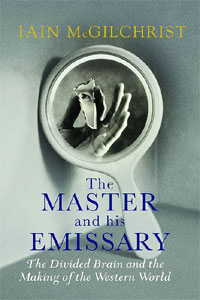
As Dr. Iain McGilchrist writes in “The Master and his Emissary: The Divided Brain and the Making of the Western World,”
the book which is a major influence on this Right Brain Network website:
“So, the left hemisphere needs certainty and needs to be right. The right hemisphere makes it possible to hold several ambiguous possibilities in suspension together without premature closure on one outcome.”
This insight is connected on a deep level to Robert Thurman’s, previously mentioned:
“Wisdom is the tolerance of cognitive dissonance.”
Note: Robert Thurman and Iain McGilchrist were the first two guests on our webinar series “What Are We Thinking? A Trip into the Right Hemisphere of the Human Brain.”
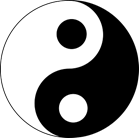
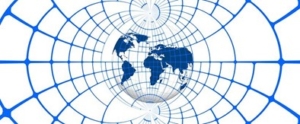
CODA
As we encounter the challenge of the sped up, digitalized, globalized, network-connected 21st century, slowing down our brain waves from the hyperactive beta state to the more reflective, intuitive, open-minded right-hemisphere feels like a much-needed shift.
And if we see the yin/yang symbol as a metaphor for our brain, it can be imagined as pointing to the need for whole-brain thinking, with the two hemispheres working more in concert. Given the well-researched, well thought-out premise of Iain McGilchrist’s “The Master and his Emissary: “The Divided Brain and the Making of the Western World:” Western culture has been dominated for centuries by the overly self-assured, technologically oriented left hemisphere, then to achieve whole brain thinking requires a re-balancing shift to a more right hemisphere perception of the deep, powerful patterns of change occurring under the surface of the anxiety-producing 24-hour news cycle.
The yin/yang symbol, apparent oppositions folding in and out of one another, reflecting an implicit Flow & Unity underneath, is much more capable of being felt and understood in the right-hemisphere of our brains’ ability to tune into the alpha and theta brain wave frequencies, to intuit the Whole and not just the parts, to understand collaboration has a greater presence in nature than does competition, to see beyond materialism to the deeper, more pervasive non-material pattern of existence.
END.
Enjoy exploring this week’s quotes and links:
“At heart, science is the quest for awesome – the literal awe that you feel when you understand something profound for the first time. It’s a feeling we are all born with, although it often gets lost as we grow up and more mundane concerns take over our lives.”
― Sean Carroll, Theoretical Physicist
“The materialistic consciousness of our culture … is the root cause of the global crisis; it is not our business ethics, our politics or even our personal lifestyles. These are symptoms of a deeper underlying problem. Our whole civilization is unsustainable. And the reason that it is unsustainable is that our value system, the consciousness with which we approach the world, is an unsustainable mode of consciousness.”
― Peter Russell, author, “The Global Brain”
“Dialogue is a space where we may see the assumptions which lay beneath the surface of our thoughts, assumptions which drive us, assumptions around which we build organizations, create economies, form nations and religions. These assumptions become habitual, mental habits that drive us, confuse us and prevent our responding intelligently to the challenges we face every day. “
—David Bohm, Quantum Physicist/Philosopher
